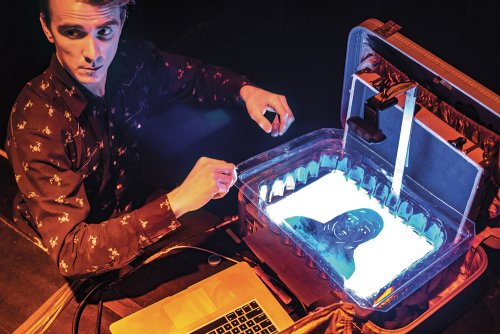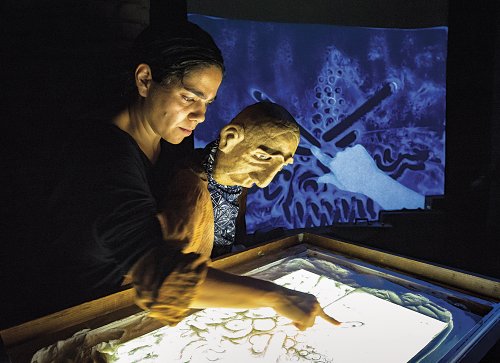Paradox Teatro
Paradox Teatro
When Mexican puppeteer Sofía Padilla met Davey T. Steinman, a performance artist who hails from Minnesota, while volunteering at Vermont’s celebrated Bread and Puppet Theater in 2015, they were right in the thick of it, Padilla says, “stomping on clay and doing papier mâché for a 10-foot-long puppet hand.” Perhaps they didn’t realize it then – with glue on their hands and clay on their feet – but that initial collaboration would soon blossom into a romantic partnership and the formation of their own touring puppet theater, Paradox Teatro.
Run by Padilla, 35, who also tours with Bread and Puppet Theater, and Steinman, 31, who freelances in video projection and design, Paradox is a bilingual company that strives to overcome language and cultural barriers using music, puppets, and technology. The couple splits time between the US and Mexico, writing, directing, and performing shows together that address the physical, cultural, and political borders dividing the two nations they call home.
As an international company, Paradox takes full advantage of puppetry’s portability. As soon as it was formed in 2017, the duo took the show on the road. “We christened our company that summer by touring Europe with a suitcase-sized travel performance,” says Padilla. The pair also has a nimble mindset when it comes to language. “Combining puppetry with video projection and live music allows us to layer ideas without relying on words,” Steinman says.
The couple takes this idea to heart when it comes to performing across borders. This summer, they’re working on Migraciones, a production for which they received a Jim Henson Foundation grant earlier this year (an especially fitting honor in light of Padilla’s stint as the assistant director of Monstruos Supersanos, a Sesame Street spin-off, in Mexico City for the 2016 season). They’ve embarked on six international working trips, and their recent US tour took them to New York’s Puppet Fringe Festival, the Contemporary Arts Center in Cincinnati, and the Open Eye Figure Theatre in Minneapolis.
The story of Migraciones is inspired by the duo’s shared fear of increasingly harsh US-Mexico border restrictions and the potential loss of a future together, Padilla says. “We needed to talk in our show about it, bringing more awareness to the subject, and also in honor of all the people whose needs push them to migrate far away from their homes forever.”
The resulting production is told from the point of view of a world-weary, life-sized puppet carrying a camera. During the performance, Padilla sketches photographs of the puppet’s journey – desert scenes with people, trucks, animals, plants, and, finally, the construction of a wall – in baking soda atop a light box; the images are projected onto a screen.
Padilla designs and builds all of Paradox’s puppets, while Steinman builds technical equipment such as the light box. He also performs the music, while Padilla delivers the spoken lines in both English and Spanish. The resulting whole, when the pair takes the stage, is more than the sum of its parts. “There is an uncanny magic in transferring emotions, rhythm, and breath to a puppet to bring it to life,” Steinman says. It may be magical, but it’s not easy. “Sometimes it’s crazy to work from different countries,” Padilla adds, “but the cross-cultural exchange also allows us to enrich our shows. We want to show the world that positive exchange between our countries is possible.”



